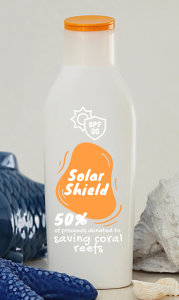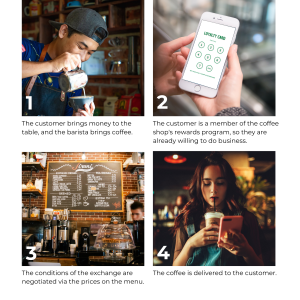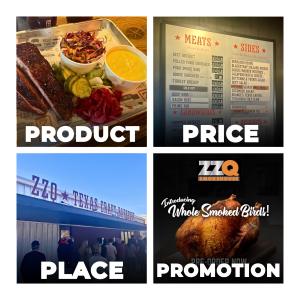Jodie L. Ferguson, Ph.D.

marketing elements (i.e., products, prices, promotions, and places) are the front-facing outputs of an organization to the
community it serves.
Understanding what marketing is and how marketing can be effectively utilized for positive brand-building is essential to maximize value to shareholders, consumers, and society.”
-Jodie L. Ferguson, Ph.D., Chapter 1 Author

INTRODUCTION
Marketing affects our everyday lives in countless ways. For example, the screen you are viewing, the clothes you are wearing, the drink in your cup, the podcast you are listening to, and the smells from the nearby coffee shop have all been influenced by marketing decisions. As people who consume, much of what we experience through our senses has been made possible through marketing efforts.

Marketers aim to provide value, to enhance lives, and to satisfy people’s and organizations’ needs. Of course, there is much more that marketing entails! This chapter introduces some of the basic concepts of marketing, including the definition of marketing value, needs and wants, and satisfaction. The topic of relationship marketing is also introduced. Five marketing management orientations are presented, the conditions for an exchange are examined, and finally, the 4Ps of the marketing mix are introduced.
“Marketing”, as defined by the American Marketing Association “is the activity, set of institutions, and processes for creating, communicating, delivering, and exchanging offerings that have value for customers, clients, partners, and society at large”. Slide to the left on each word for it’s marketing definition and to learn more about marketing’s components.
NEEDS AND WANTS
A need is when there is a gap between a person’s actual state and a desired state. A want is when the person knows a product that will fulfill the need, in an effort to get that person to their desired state.
 For example, imagine Cheryl goes to her sink to wash her hands after spending the morning weeding her garden. She presses the soap dispenser, but nothing comes out! The dispenser is empty. Cheryl’s actual state is having dirty hands, and her desired state is clean hands. She knows from experience that using hand soap will help her achieve her desired state—clean hands.
For example, imagine Cheryl goes to her sink to wash her hands after spending the morning weeding her garden. She presses the soap dispenser, but nothing comes out! The dispenser is empty. Cheryl’s actual state is having dirty hands, and her desired state is clean hands. She knows from experience that using hand soap will help her achieve her desired state—clean hands.
She remembers that buying more Softsoap (her favorite brand) hand soap at the grocery store, filling the dispenser with that soap, and then washing her hands will result in getting her hands clean. To summarize, Cheryl’s need is clean hands and the want is Softsoap hand soap.
SATISFACTION
Before an individual experiences a product, they have an expectation of what the product experience will be like. Then, after the experience occurs, the individual compares what was anticipated to what actually happened with the product. If expectations about the product were met or exceeded, then satisfaction was achieved. When expectations about the product are not met, then dissatisfaction was achieved.
Satisfaction has been linked to positive behaviors such as word-of-mouth marketing and repurchase behaviors. Positive word-of-mouth provides the company with free consumer-generated marketing and can take many forms from a customer recommending a brand to their friends and family, to writing an online review on Google, to posting an unboxing video on TikTok.
Another related construct that is a good predictor of loyalty behaviors is a customer’s willingness to recommend a product or brand. One way to measure customer loyalty is by using the Net Promoter Score or NPS, a number based on asking consumers about their likelihood to recommend the company on a scale of zero to ten. NPS is measured by deducting the percentage of detractors (reported likelihood of 0 to 6) from the percentage of promoters (reported likelihood of 9 and 10).
MARKETING MANAGEMENT ORIENTATIONS
As marketing has progressed through the years, so has the concept of marketing management orientation, the overarching philosophy guiding marketing managers in decision-making. The five marketing management orientations are the production, the product, the selling, the marketing, and the societal marketing orientations (Armstrong).
The first orientation is the production orientation.
At the heart of the production orientation is the process to create the product offering. The focus is on manufacturing efficiencies, lowering production cost, and improving procedures, such as with assembly lines and technology. The customer may have limited choices in the product offered.

This could look like a clothing company, “Woven by Walt,” that designs, manufactures, and sells flannel shirts. They spend much of their time asking questions like, “How do we get cheaper textiles for our shirts,” “What machines in our factory will allow us to produce the most shirts per day,” and “What packaging materials would cost less than our current cardboard boxes?”
The next marketing management orientation is the product orientation.
 In this orientation, marketers traditionally focus on putting a high quality product on the market. The other areas of marketing are not engaged, which means the customer must come to the seller to find out about product offerings and choices are limited. For example, imagine a seed company called “Get Plantin’” that only offers carrot and eggplant seeds, and who doesn’t actively promote or advertise their business to the public.
In this orientation, marketers traditionally focus on putting a high quality product on the market. The other areas of marketing are not engaged, which means the customer must come to the seller to find out about product offerings and choices are limited. For example, imagine a seed company called “Get Plantin’” that only offers carrot and eggplant seeds, and who doesn’t actively promote or advertise their business to the public.
The selling orientation focuses on bringing a product to the customer. The product and production elements of the business have been established and there is a surplus of product that needs to be sold. In this orientation, mass selling is the goal.

An example of a business operating within this orientation might be an organic juice company called “Juice Jamboree.” They have already developed the formulas for their product as well as the manufacturing processes to create large quantities of the product. Now, they are partnering with a national supermarket chain to start selling on a much larger scale. To promote their product, Juice Jamboree has a large sales force to hand out product samples to consumers in supermarkets.
A focus on the customer is the marketing orientation. With this orientation, marketers seek out customer needs and wants and put forth product offerings that meet those needs and wants. In a marketing orientation, the customer is at the heart of all marketing decisions.

Here, we can picture a running shoe company, “Fleet Feet,” that is trying to compete against larger, more well-established companies. In order to entice runners to try their shoes, Fleet Feet does extensive consumer research and uses the information they learned to design their products and to create an advertising campaign introducing their shoes to the public.
Finally, the societal marketing orientation is one in which the customer is the focus of marketing decisions, however, there is an emphasis on society and the greater environment surrounding the customer in decision making.

We can think of a sunscreen company called “Solar Shield” that values customer feedback when developing new products, while also donating money to rehabilitate coral reefs damaged by sunscreen usage, as well as advocating for greater funding for skin cancer research.
As focus on satisfying customer needs and wants has become more prolific, marketers have naturally moved more from product, production, and selling orientations to marketing orientations. And similarly, as communities have shifted their attention more towards societal issues, societal marketing orientations have become more prominent, with brands communicating how they are supporting societal and environmental issues.
It is noteworthy that some firms still do operate in product, production, or selling orientations based on the organization’s mission and goals.
RELATIONSHIP MARKETING
A marketing relationship occurs between two or more parties (e.g., organizations or individuals) when there is more than one interaction, and there is a desire from the parties to continue interactions in the future. Marketers who engage in relationship marketing are striving to build productive relationships with clients, customers, and other entities in efforts to provide mutually beneficial value. Loyalty programs are an example of how practitioners are engaging in relationship marketing to learn more about consumer behaviors, to engage consumers with personalized messaging, and to encourage loyalty behaviors.
THE EXCHANGE
There are several conditions that must be met for an exchange to occur. First, there must be two parties, each bringing something of value to the exchange. The two things of value in the exchange are usually a marketing offering or product, and on the other side money or credit. Second, the two parties must be willing to do business with each other. Third, the conditions of the exchange must be negotiated. This step may be as simple as a retailer offering a price and the customer agreeing to pay the price offered. Fourth, the delivery terms must be worked out. Below is an example of an exchange.

CUSTOMER VS. CONSUMER
Before we get much deeper into marketing, let’s make sure we are clear on something. As a marketer, you may hear the word “customer” and “consumer” used interchangeably. This substitution is not always wrong, but it is not always right, either. A consumer is a person who consumes marketing offerings for their own personal use. The consumer is also considered the end-user or the last link in the supply chain.
For example, Sally goes to Staples to buy paper and uses the paper to write her grocery list. Sally is using the paper for her own, personal use, and therefore is a consumer.


The customer, on the other hand, is the receiver of marketing offerings, and may or may not be the person or organization actually using the product. The customer may be consuming a product, however, that consumption of the product may be for business use and not intended for personal consumption. In this sense, all consumers could be considered customers, but only consumption for personal use signifies the distinction of consumer. For example, office manager Sam may purchase paper from Staples for Sam’s company and write a list of work activities on the paper. Sam is consuming the paper, but the consumption is not for Sam’s personal usage. The use, in this example, is for furthering company business goals. Thus, Sam is a customer, but not a consumer.
THE MARKETING MIX
As humans, we are all consumers of goods, services, and ideas—referred to as the concept of PRODUCT. We benefit from goods and services brought to us by stores both online and brick-and-mortar (PLACE). We make purchases based on posted PRICE. We attend to marketing PROMOTION messages daily. To these ends, the concepts of product, place, price, and promotion—referred to as the 4Ps of the marketing mix—all fall under the umbrella of marketing decisions. In its simplest form, marketing brings the marketing mix to identified target markets, that is, people or organizations who the marketer wants to buy products and engage in productive relationships with.
The 4 Ps of ZZQ

The decisions around product, place, price, and promotion are within the control of the marketer, however there are influencers on the 4Ps that are outside the control of the marketer. For example, COVID-19 had an influence on the products put forth in the marketplace, the way products got into consumers’ hands, the price for those products, and the promotion for those products. Therefore, marketers must react and adjust accordingly. While marketers can influence the market they are targeting only to some degree, they can be strategic in the market they plan to target.
THE HANDBOOK
This handbook is designed to provide an overview of the marketing umbrella. While marketing basics were defined in the current chapter, the remainder of the handbook centers on topics of marketing and markets, the marketing toolkit, and the marketing mix. First, a closer look at customer behaviors, both consumer-centric (Ch 2) and business-centric or B2B (Ch 3), are considered. Included in this focus on markets is International Marketing (Ch 4). The marketing toolkit focuses on marketing strategy (Ch 5), understanding insights in marketing research (Ch 6), and segmentation, targeting, and positioning (Ch 7). The final block of the handbook investigates the marketing mix and the important marketing decisions around product (Ch 8), distribution (place) and marketing channels (Ch 9), and pricing (Ch 10). Lastly, the final P of the marketing mix, “promotion,” is examined in three chapters: integrated marketing communications, advertising, public relations, and sales promotion (Ch 11), personal selling and sales management (Ch 12), and digital marketing (Ch 13).
REFERENCES
“Definitions of Marketing.” American Marketing Association. https://www.ama.org/the-definition-of-marketing- what-is-marketing/
Reicheld, Frederick F. “The One Number You Need to Grow.”Harvard Business Review. https://hbr.org/2003/12/the-one-number-you-need-to-grow. December 2003.
Armstrong and Kotler. Principles of Marketing. Pearson. 2017.
Media Attributions
- Header by Z. Farley
- Blanchard’s Coffee by Z. Farley
- NRCS photo by Brooke DeCubellis, licensed under PDM 1.0
- Flannel Photo by Tradlands, licensed under CC BY 2.0
- Carrot Seeds by normanack, licensed under CC BY 2.0
- Smoothies by zoetnet, licensed under CC BY 2.0
- Billboard by Mariakray via Pixabay, licensed under CC0
- Sunscreen by Bellahu123 via Pixabay, licensed under CC0
- The exchange grid: photo 1 by Peggy_Marco, photo 2 by JESHOOTS, photo 3 by Pexels, photo 4 by Averyanovphoto, all via Pixabay, licensed under CC0
- Sam by StockSnap via Pixabay, licensed under CC0
- Sally by by Surprising_SnapShots via Pixabay, licensed under CC0
- ZZQ by Z. Farley
The activity, set of institutions, and processes for creating, communicating, delivering, and exchanging offerings that have value for customers, clients, partners, and society at large
When there is a gap between a person’s actual state and a desired state
When the person knows a product that will fulfill the need, in efforts to get the person to their desired state.
A one question survey with the goal of maximizing the number of promoters (those who score 9 or 10) minus the number of detractors (those who score 0 to 6)
The overarching philosophy guiding marketing managers in decision-making
Marketers focus on manufacturing efficiencies, lowering production cost, and improving procedures, such as with assembly lines and technology
Marketers traditionally focus on putting a high quality product on the market
Marketers focus on bringing a product to the customer
Marketers seek out customer needs and wants and put forth product offerings that meet those needs and wants
Marketers focus on the customer, however, there is an emphasis on society and the greater environment surrounding the customer in decision making
A relationship between two or more parties (e.g., organizations or individuals) when there is more than one interaction and there is a desire from the parties to continue interactions in the future
A person who consumes marketing offerings for their own personal use
The set of people or organizations that receive marketing offerings
Product, place, price, and promotion
